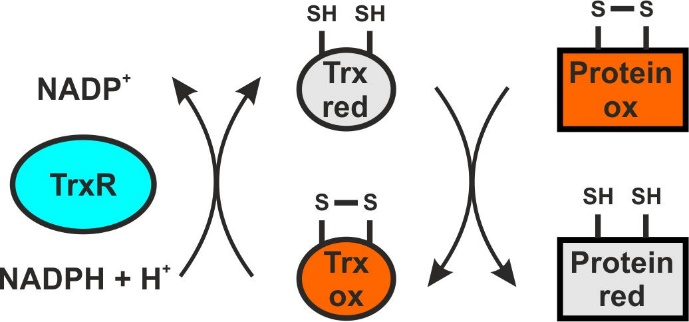10. University of Rostock-supported project – Redox regulation of mitochondrial metabolism – thioredoxins as master switches to control plant carbon fluxes in a changing environment, Dr. Stefan Timm (University of Rostock)
joint project together with Prof. Danilo M. Daloso (University of Fortaleza, Brazil), Prof. Alisdair R. Fernie (Max-Planck Institute for Molecular Plant Physiology, Golm, Germany) and Prof. Peter Geigenberger (Ludwig-Maximilians University Munich, Germany

Despite comprehensive knowledge on the biochemistry and genetics of central carbon and nitrogen metabolism it is still largely unknown how the interplay of the different pathways is regulated. Thioredoxins (Trx) are small proteins that translate changes in the (sub)cellular redox-state onto protein activities to regulate the flux of metabolic pathways. This mechanism is well known for the plant chloroplast, particularly the light activation of the Calvin-cycle (Michelet et al. 2013). Two mitochondrial Trx proteins, namely Trx o1 and h2, were identified to regulate the flux through the TCA-cycle (Daloso et al. 2015) and, more recently, mitochondrial photorespiratory 2PG metabolism (Reinholdt et al. 2019a, Fonseca-Pereira et al. 2020). Recently, we identified the mitochondrial dihydrolipoyl dehydrogenase (mtLPD1) as the major target of Trx regulation in plant mitochondria. This regulation is of particular importance since mtLPD1 participates in the function of four mitochondrial multi-enzyme complexes, the TCA-cycle complexes 2-oxoglutarate dehydrogenase (OGDH) and pyruvate dehydrogenase (PDH), the photorespiratory glycine decarboxylase (GDC), and the branched chain ketoacid dehydrogenase (BCKDH) involved in the degradation of specific amino acids. Our results suggest that proper Trx regulation in mitochondria is necessary for rapid induction of photosynthetic induction after the onset of light (Reinholdt et al. 2019b), which supports the hypothesis that mitochondrial Trx are involved in short-term acclimation to environmental changes. Our current research focuses on three different aspects: (I) do Trx o1 and h2 display redundant or specific regulatory functions, and if so, (II) under which environmental conditions do Trxo1 and h2 specifically regulate the carbon flux through the three different pathways? (III) Finally, we want to identify further proteins that compensate the loss of Trxo1 of h2. To achieve these goals, we analyze Arabidopsis wild-type and specific mutant plants by a broad range of physiological methods in combination with LC-MS/MS- and GC-MS-based metabolite analysis as well as targeted 13C-labelling strategies. Transcriptional and proteomics analysis will be used to complete the experimental toolbox.
References:
Daloso, DM, Müller K, Obata T, Florian A, Tohge T, Bottcher A, Riondet C, Bariat L, Carrari F, Nunes-Nesi A, Buchanan BB, Reichheld J-P, Araújo WL, Fernie AR (2015) Thioredoxin, a master regulator of the tricarboxylic acid cycle in plant mitochondria. Proceedings of the National Academy of Sciences USA 112:1392-1400
Fonseca-Pereira P, Souza PVL, Hou LY, Schwab S, Geigenberger P, Nunes-Nesi A, Timm S, Fernie AR, Thormählen I, Araújo WL, Daloso DM (2019) Thioredoxin h2 contributes to theredox regulation of mitochondrial photorespiratory metabolism. Plant Cell and Environment 43:188-208
Michelet L, Zaffagnini M, Morisse S, Sparla F, Pérez-Pérez ME, Francia F, Danon A, Marchand CH, Fermani S, Trost P, Lemaire SD (2013) Redox-regulation of the Calvin-Benson cycle: something old, something new. Frontiers in Plant Science 4:470
Reinholdt O, Schwab S, Zhang Y, Reichheld JP, Fernie AR, Hagemann M, Timm S (2019a) Redox-regulation of photorespiration through mitochondrial thioredoxin o1. Plant Physiology 181:442-457
Reinholdt O, Bauwe H, Hagemann M, Timm S (2019b) Redox-regulation of mitochondrial metabolism through thioredoxin o1 facilitates light induction of photosynthesis. Plant Signaling & Behavior, DOI: 10.1080/15592324.2019.1674607






